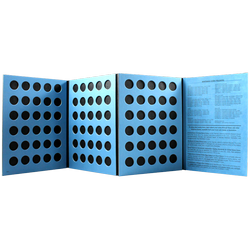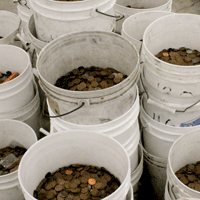
Collecting vs Hoarding
Sometimes there can be a fine line between collecting something, whether it’s a certain object (like lawn ornaments) or a theme (like angels) or anything else one acquires over time, and hoarding that same thing. But when it comes to the hobby of coin collecting, most people would agree that there are distinctive differences between the two. 
Coin collecting can generally be defined as the act of assembling sets of coins based on a common attribute. Common attributes that coin collectors use to assembly their coin sets include: sets of coins from the same year; sets of certain types of coins (i.e. every year of quarters, or dimes, etc); sets of certain mint marks; sets of coins from certain countries; or sets of certain coin designs (coins featuring animals, for instance). Coin collections are almost always stored and displayed in collector’s albums, folders, frames, display cases, etc.
In contrast to building sets based on certain attributes, coin hoarding could be defined as accumulating large amounts of coins over time with no intention of building any kind of set. There could be several reasons that someone would choose to do this, but one common reason is the amount of precious metal (silver, copper, etc) in certain coins, which can make them worth more than their actual face value. Another practice is the hoarding of coins of a certain design that is no longer produced (such as wheat cents), but without organizing them into any kind of sets. Coin hoards are typically just stored in bulk in buckets, bins, jars, coin sacks, or something similar.
(such as wheat cents), but without organizing them into any kind of sets. Coin hoards are typically just stored in bulk in buckets, bins, jars, coin sacks, or something similar.
Over the past few years it has become more and more common for some people to "hoard" United States One Cent coins. Since these coins are called pennies by most Americans, this practice is most often referred to as penny hoarding. Of course, this reference doesn’t include the single penny jar you keep for a rainy day or your kids’ piggy banks. We’re talking quantities of pennies so large that they have to be stored in garages, basements or sheds. And penny hoarders aren’t looking for just any penny, they are only interested in those dated 1982 or earlier. But why you might ask? Pennies from that era contain 95% copper, and with the increasing value of this precious metal these coins would each be worth more than their one cent face value. The key part of this statement is “would be”. It is actually against the law to melt down these coins to sell as scrap. (It is also illegal to transport more than $5.00 in pennies out of the United States.) So basically, penny hoarders are banking on this legislation to change in the future. There has been an ongoing debate as to the possibility of discontinuing the  production of one cent coins in the U.S., as manufacturing costs to make pennies continues to outpace their face value. If the production of one cent coins ever does cease, the legislation just may change to allow people to get at the copper content of their older one cent pieces.
production of one cent coins in the U.S., as manufacturing costs to make pennies continues to outpace their face value. If the production of one cent coins ever does cease, the legislation just may change to allow people to get at the copper content of their older one cent pieces.
SilverTowne has recently acquired one such penny hoard, containing thousands of Lincoln Wheat Cents. Since purchasing this hoard, we have been hard at work sorting through the many coin sacks stuffed full of these wheat cents. We’ve divided them into lots of certain date ranges and now have them for sale on our website. You can choose from bags of 1909-1958 wheat cents in random lots of 5 pounds worth (approximately 740-750 pieces), 2500 pieces or 5000 pieces. Also available are 100 piece bags of more narrow date  ranges from the 1910s, 1920s or 1930s. There is even a 100 piece bag containing all Steel Wheat Cents. Now is the perfect time to stock up on these popular coins – whether adding to a collection or starting a brand new one. Every coin collector knows what fun it is to sort through a bag of coins looking for those extra-special treasures. So stock up now and have fun sorting through your new wheat cents!
ranges from the 1910s, 1920s or 1930s. There is even a 100 piece bag containing all Steel Wheat Cents. Now is the perfect time to stock up on these popular coins – whether adding to a collection or starting a brand new one. Every coin collector knows what fun it is to sort through a bag of coins looking for those extra-special treasures. So stock up now and have fun sorting through your new wheat cents!







